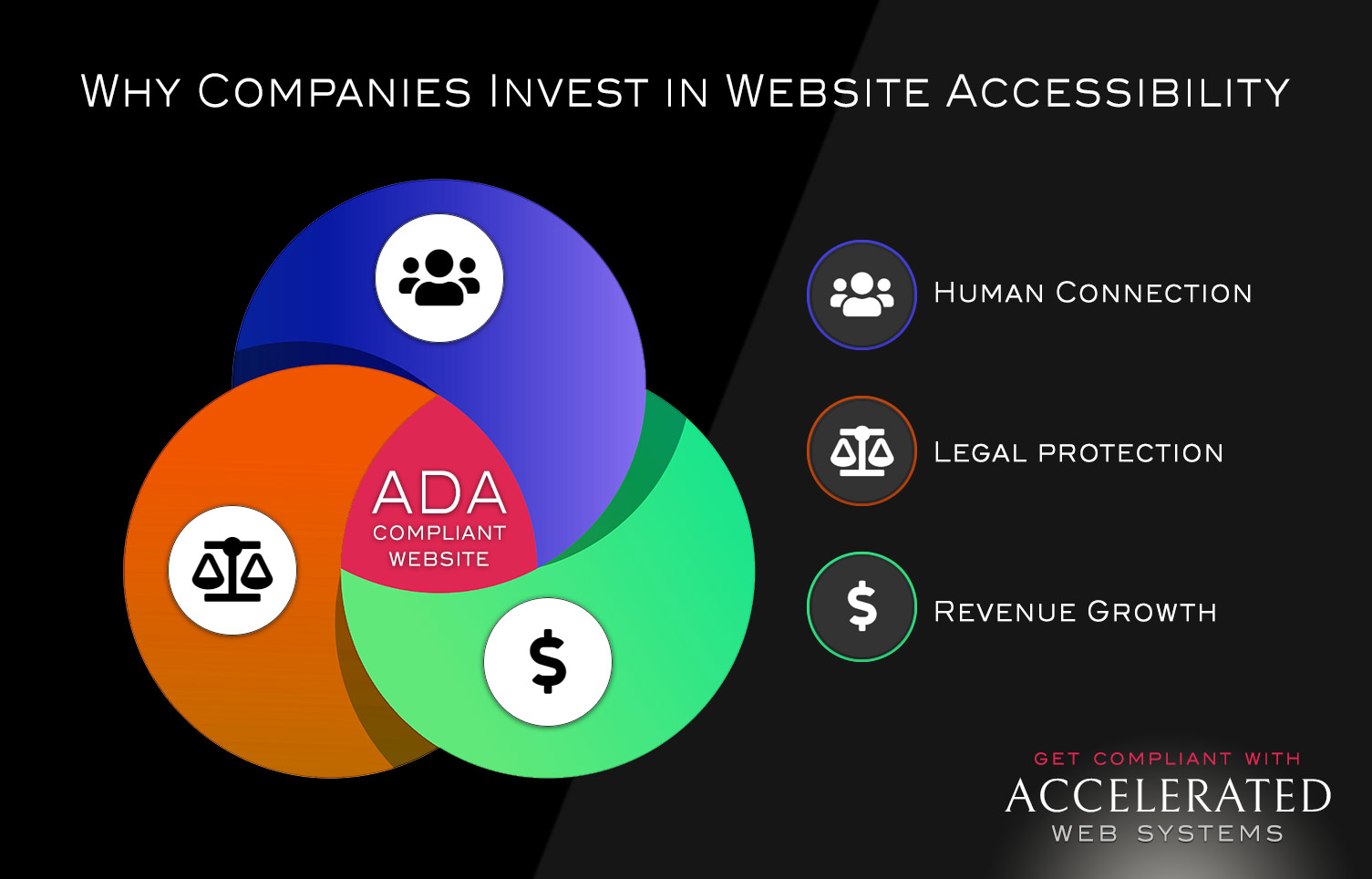The Case for ADA Website Compliance: Human Connection, Legal Protection, and Revenue Growth
According to the MOZ website, 18.9% of the total American internet population has a disability.
Your website is the digital face of your business. Is it inclusive, professional, and welcoming?
Or, is it difficult or impossible for some people to use?
Can you imagine how frustrating that is… for a person who might become a client or customer… to experience all this friction on your website?
Do you think they are going to stick around… for even more than a few seconds?
Probably not.
Why would a business owner want to make it so hard for a person to give them their money?
These barriers can be removed by making your website ADA-compliant (Americans with Disabilities Act).
Making your website accessible is your ethical responsibility and has numerous practical benefits as well.
By removing barriers and making your website accessible to all, your website can achieve three things for your business:
The Human Connection
At its core, ADA compliance is about people. By making your website accessible, you are creating an inclusive digital space where everyone, regardless of their abilities, can navigate, engage, and enjoy the content on your site. The human connection is an integral aspect of your business’s brand identity and customer experience. Ignoring accessibility means you risk excluding 61 million adults in the U.S. living with disabilities, potentially alienating customers and missing out on connecting with them on a human level.
Accessibility features—like alt text for images, keyboard navigation, and readable fonts—allow individuals with visual, auditory, and motor impairments to interact with your website. When these users can access your content without obstacles, they are more likely to trust your brand, return to your site, and make purchasing decisions.
Stats:
- Websites that are accessible attract a larger audience. Over 15% of the global population lives with some form of disability.
- Businesses that prioritize accessibility increase customer loyalty by creating a positive user experience for everyone, which can result in repeat visitors and word-of-mouth referrals.
FREE DOWNLOAD: ADA Compliance Checklist for Your Website
Legal Protection
Beyond ethical considerations, having an ADA-compliant website protects your business from costly lawsuits. In recent years, there has been a surge in legal action against businesses with inaccessible websites. In 2023, there were 4,798 website accessibility lawsuits filed in the United States. Non-compliance with the ADA can result in hefty fines and damage to your business’s reputation.
The ADA requires that all businesses, particularly those that offer goods and services online, make their websites accessible to individuals with disabilities. Failing to meet ADA standards could mean legal action under federal law, particularly Title III of the ADA, which applies to public accommodations.
Stats:
- In 2021, 265,000 website accessibility demand letters were sent out to businesses with an estimated $25,000 per case to resolve the demand letter and then proceed with fixing accessibility issues.
- The number of ADA website lawsuits increased by 12% from 2022 to 2023.
- ADA-related settlements for non-compliant websites can range from $10,000 to $50,000, depending on the severity of the violation and the size of the business. However, there are instances where settlements can amount to hundreds of thousands of dollars or more than a million (Target had to pay 6 million in 2018, and Harvard had to pay $1,575,000 in 2020.)
- Most companies that received lawsuits have annual revenue under 25 million.
- eCommerce and restaurant/food websites offering online ordering face the most lawsuits.
- Lawsuits filed against companies using accessibility widgets currently account for 20-30% of the complaints, and the number is growing.
Revenue Growth Through SEO and User Experience
An ADA-compliant website can directly lead to increased revenue through better search engine optimization (SEO) and improved user experience. Google and other search engines prioritize websites that provide a seamless user experience, which includes accessibility. Features such as descriptive alt text, clear navigation, and mobile optimization improve your SEO rankings, bringing more traffic to your website.
In addition to SEO benefits, an accessible website reduces bounce rates by allowing users to find what they need more easily. When users can’t access content or features due to barriers, they quickly leave—leading to higher bounce rates and lost revenue opportunities. ADA compliance helps ensure that your website is usable for a broader audience, keeping visitors engaged for longer.
Web and Digital Accessibility for Small Business by Charlotte Howard
And so…
An ADA-compliant website is not just a legal requirement; it is a reflection of your business’s values and an investment in its future growth.
Prioritizing accessibility allows you to connect with all customers, protect your business from legal issues, and improve your bottom line through enhanced SEO and user experience.
Don’t let your website be a barrier—make it an inclusive space for everyone.
Sources:
- Moz.com
- CDC: Disability Impacts All of Us
- WHO: Disability Statistics
- UsableNet: ADA Lawsuit Reports
- Disability Report
- Seyfarth Shaw ADA Lawsuit Trends
- SEMrush Accessibility SEO Study
- HubSpot: User Experience and Conversion Data
- Who is Accessible
This article outlines not only the ethical responsibility but also the practical benefits of having an ADA-compliant website, providing solid reasons for businesses to act now.
If you’re ready to make your site ADA website compliant, schedule a call with us at Accelerated Web Systems. We can help!


